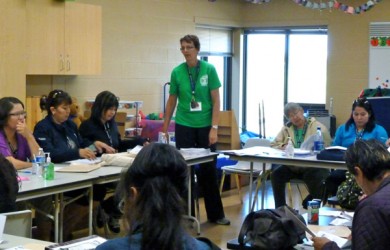Article Origin
Volume
Issue
Year
Education was the topic at Communities Learning Together’, a two-day conference for northern Cree and Dene communities, hosted by the Meadow Lake Tribal Council (MLTC) on Aug. 23-24.
Approximately 260 teachers, principals, chiefs, Elders and leaders from the nine First Nations of Flying Dust, Makwa Sahgaiecan, Big Island Lake, Waterhen Lake, Canoe Lake, Clearwater, English River, Buffalo River, and Birch Narrows attended the first-time event held at the Flying Dust First Nation.
“(We) got all the staff from the nine First Nations together in one place,” said MLTC’s recently appointed Education Director, Judy Okanee. “It was a very positive way to open the school year. It was very educational, it gave a sense of ownership with the new staff that comes in and the ones that have been there (other years),” she added.
Both days were started with a pipe ceremony followed by break out sessions, an evening banquet and cultural entertainment.
The first session had the chiefs, principals, education directors, Elders, education portfolio holders, and the staff of each school sit down and talk about education goals, objectives and visions. The second breakout session had staff from each grade level in the nine First Nations communities separate into groups.
“That allowed all the staff to get together and find out what’s happening in everyone else’s community,” said Okanee. “(They) are a wonderful tool to find out what’s happening and what are the new curriculums out there. What works, what doesn’t work.”
The good thing about the overall conference, said Okanee, is it allowed teachers and staff to meet the band leadership and community Elders.
“It was a great chance to get connected,” she noted. “Everybody was there to hear the same thing and that was very, very positive.”
One participant commended the work of organizers to hold the conference.
“(It) was organized very well and appeared to run smoothly,” the conference participant stated anonymously. “I am sure that was due to the hard work of many people… we were very impressed with the event.”
Some of the topics included First Nations language, special education, practical and applied arts, and discrepancies with funding and tuition amounts given to First Nations schools.
“That’s been the biggest issue and that will continue to be the biggest issue until it’s fixed. Or at least improved,” said Okanee.
“We don’t get funded at the same rate as the provincial system. And the expectations are that we perform on par.”
Regardless, she said, educators in the schools are passionate about what they do and find ways to make it work. One example of success is seen in the First Nations Students Success Program (FNSSP), which will help in education goals and objectives. The pilot program is funded through Indian Affairs with the aim of improving literacy, numeracy, graduation rates, and retention rates.
“And so that will help and we are on the beginning of the second year and hope it will be a six-year program that we could see some positive results,” said Okanee.
When asked about the issue of high drop-out rates in First Nations communities, Okanee offered her view as an educator for 34 years, on what she thinks would be helpful in addressing the challenge that has existed for many years.
“The first thing we need to do is introduce the culture and the language and get them to understand who they are, why they belong here and why they need to take a positive role,” she said.
“As First Peoples our children do not realize a lot of things that have not been taught in school and as First Nations we should be doing that,” she added.
“Language and culture is a big push in order to get our kids ready for both worlds.”
A news release issued by MLTC, states that the Office of Education provides second-level services to support the nine Meadow Lake First Nations in its community education programs.
- 2788 views

